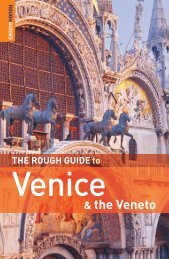Create successful ePaper yourself
Turn your PDF publications into a flip-book with our unique Google optimized e-Paper software.
50 <strong>dubrovnik</strong> neretvA CountY<br />
are a number <strong>of</strong> harbour ports in Mljet. Polače is its largest and<br />
main port <strong>of</strong> call in <strong>the</strong> north. O<strong>the</strong>r harbours include Okuklje,<br />
Luka Prožura, Sobra, Kozarica and Pomena (which has daily<br />
connections to Dubrovnik. Watch out for reefs and shallow<br />
water. At Lokve or Gonoturska port where you can throw<br />
anchor just before <strong>the</strong> entry canal toward <strong>the</strong> Big Lake.<br />
N<br />
0 500 1000 1500<br />
1 : 50 000<br />
MLJET<br />
Hr Šij<br />
Crna seka<br />
Pomeštak<br />
Hr Štit<br />
Glavat<br />
Crna seka<br />
Pomena<br />
Maslinovac<br />
Goveđari<br />
Pristanište<br />
V. Jezero<br />
Iryna Khotenko<br />
Adrien Therond<br />
What to See<br />
National Park Mljet (Nacionalni Park Mljet)<br />
Pristanište 2, Goveđari, tel. 74 40 41, np-mljet@<br />
np-mljet.hr, turizam@np-mljet.hr, www.np-mljet.hr.<br />
Established in 1960, <strong>the</strong> park is Mljet’s top attraction. The<br />
park encompasses 54 square kilometres at <strong>the</strong> western end<br />
<strong>of</strong> <strong>the</strong> island, with an astonishing interior and coastline beauty.<br />
Veliko Jezero and Malo Jezero (Big Lake and Small Lake),<br />
and <strong>the</strong> villages <strong>of</strong> Soline, Babine Kuće, Pomena, Polače and<br />
Goveđari all lie within <strong>the</strong> park boundaries. Of interest, this<br />
park represents <strong>the</strong> first institutionalised attempt to protect<br />
<strong>the</strong> native eco-system in <strong>the</strong> Adriatic.<br />
Polače<br />
Tajnik<br />
Soline<br />
Moračnik<br />
Ovrata<br />
Kobrava<br />
Vanji školj<br />
The lakes, 145-hectare Veliko Jezero and 24-hectare Malo<br />
Jezero, are <strong>the</strong> park’s dominant features. Thirty-metre-long<br />
channels link <strong>the</strong> two lakes and provide an outlet from Veliko<br />
Jezero to <strong>the</strong> sea. The current in <strong>the</strong> channels, swift enough to<br />
power mills during <strong>the</strong> Middle Ages, switches direction every<br />
six hours. On foot or by pedal you can enjoy a 9-kilometer<br />
path which circumnavigates <strong>the</strong> lakes, and o<strong>the</strong>r paths wind<br />
up and over <strong>the</strong> hills. It’s OK to swim or paddle in <strong>the</strong> lake, but<br />
scuba diving and motor boats are not permitted.<br />
The usual national park rules apply: Don’t pick <strong>the</strong> flowers,<br />
steal <strong>the</strong> artifacts, fish without a special permit, nor litter, and<br />
most <strong>of</strong> all, don’t start fires. Mjet is one <strong>of</strong> <strong>the</strong> most verdant <strong>of</strong><br />
Croatia’s islands because it wasn’t heavily logged or used for<br />
farming or herding. Never<strong>the</strong>less, a 1917 fire took out many<br />
<strong>of</strong> <strong>the</strong> deciduous forests.<br />
Tickets to <strong>the</strong> park cost 40 - 90 kn and during <strong>the</strong> winter<br />
you should call prior coming for <strong>the</strong> ferry to be organised to<br />
St Mary Island in <strong>the</strong> middle <strong>of</strong> Veliko Jezero, where you will<br />
find <strong>the</strong> Benedictine monastery.<br />
Benedictine Monastery on <strong>the</strong> islet <strong>of</strong> St Mary<br />
(Samostan Sv Marija) This tiny island, in a lake on <strong>the</strong> island <strong>of</strong><br />
Mljet, is at <strong>the</strong> island’s cultural and spiritual heart. For a time,<br />
<strong>the</strong> monastery was <strong>the</strong> island’s governmental centre.<br />
Benedictines, members <strong>of</strong> a monastic order who live in<br />
autonomous communities dedicated to work, prayer and<br />
peace, came to Mljet from Monte Gargano, Italy in <strong>the</strong> 12th<br />
Century to establish a monastery and build a Romanesque<br />
church dedicated to St Mary, which <strong>the</strong>y completed in 1198.<br />
In <strong>the</strong> process <strong>the</strong> Benedictines became <strong>the</strong> island’s feudal<br />
lords, but <strong>the</strong>y are credited with developing literacy, culture<br />
and art. The Church <strong>of</strong> St Mary was repeatedly modified over<br />
<strong>the</strong> centuries, acquiring by <strong>the</strong> 13th Century decorative reliefs<br />
<strong>of</strong> saints and a typical Romanesque belltower. Renaissance<br />
features such as <strong>the</strong> Gundulić coat <strong>of</strong> arms over <strong>the</strong> church<br />
portal, defensive towers and walls, <strong>the</strong> two-storey structure<br />
<strong>of</strong> <strong>the</strong> monastery and Baroque side chapels were added<br />
during <strong>the</strong> 16th and 17th centuries. In 1809, during <strong>the</strong> rule<br />
<strong>of</strong> Napoleon, <strong>the</strong> monastery was abandoned and <strong>the</strong> Austrian<br />
Forestry Office for Mljet used <strong>the</strong> buildings for <strong>of</strong>fices until<br />
1941. In 1960 it was renovated into a lovely hotel but given<br />
back to <strong>the</strong> bi<strong>shop</strong>ric in 1997, just under 800 years from <strong>the</strong><br />
church’s inauguration.<br />
The church has been reconsecrated, but o<strong>the</strong>r than a<br />
restaurant in <strong>the</strong> monastery cellars (during summer), <strong>the</strong><br />
buildings are unoccupied. The island is small but <strong>of</strong>fers a<br />
pleasant walk past two chapels. You can close your eyes for<br />
a moment and imagine <strong>the</strong> monks carefully pruning, weeding,<br />
and feeding in <strong>the</strong> gardens, which are now fairly overgrown.<br />
Polače The village is named for <strong>the</strong> ruin <strong>of</strong> a significant<br />
Roman palace and fortifications – one tower is 20m high --<br />
built between <strong>the</strong> 2nd and <strong>the</strong> 5th centuries. Second in size<br />
Kozarica<br />
Polje<br />
Slatina Svinjac<br />
Dubrovnik In Your Pocket <strong>dubrovnik</strong>.inyourpocket.com<br />
Hr Kula<br />
Dugo polje<br />
Blatina<br />
Spilja<br />
B latsko polje<br />
Crkvište<br />
Ropa<br />
Roparsko polje<br />
BLATO<br />
Lazove laze Podlaze<br />
Uzdolačje<br />
Dubovca<br />
M l j e t s k i k a<br />
Žanjevac<br />
Sv. Mihajlo<br />
Lokve<br />
Hripe<br />
Zasad Podvršje<br />
P ropadi<br />
Dočić<br />
D<br />
Glog







